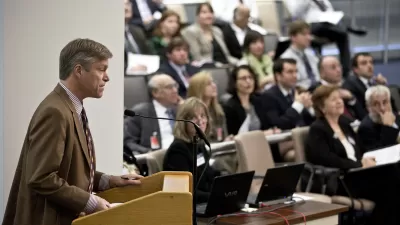For most planning programs in the U.S. this is the end of the semester. Having read literally hundreds of papers over the past few months I have reflected on the lessons of better papers for writing in planning.
For most planning programs in the U.S. this is the end of the semester. Having read literally hundreds of papers over the past few months I have reflected on the lessons of better papers for writing in planning.
- Find the right level of ambition. Papers or reports that are too ambitious risk seeming unfocused and shallow. On the other hand papers (or planning reports) lacking ambition-perhaps describing a place through one fairly standard lens-may just not say enough of interest to do really well.
- Make an argument that someone else will care about. A simple description of a standard phenomenon can demonstrate that you have some knowledge of a topic but a better paper convinces the reader that this matters to them or to the world.
- Make an argument that hangs together. Try diagramming your argument-your claim, evidence, qualifications, and so on. If you can't diagram it, you may not have much of an argument. My favorite book on writing papers-Booth et al.'s (2008) the Craft of Research-has great tips.
- Demonstrate that you understand your sources. As a planner you are typically writing for experts-other professionals, council members who know their constituencies, residents who know their neighborhoods. Using sources selectively to support opinions you merely mean to illustrate, rather than argue for, will undermine your credibility. Failing to show an understanding of which studies and datasets can support which kinds of claims will get you in similar hot water. Show you know when an oral history is great evidence and when you need a cost-benefit study.
- Use multiple data sources where possible. Making a coherent argument from statistics, observations, maps, interviews, and historical information is tricky but is likely to be a better argument than one based on a single source. Incidentally some people find certain data sources more convincing than others and you are more likely to hit on one of these sources if you use several.
- Get key technical terms right. Don't mix up the Athens Charter and the Charter of the New Urbanism-there are commonalities but experts in urban design know the difference.
This is my April blog quite late.

Alabama: Trump Terminates Settlements for Black Communities Harmed By Raw Sewage
Trump deemed the landmark civil rights agreement “illegal DEI and environmental justice policy.”

Planetizen Federal Action Tracker
A weekly monitor of how Trump’s orders and actions are impacting planners and planning in America.

The 120 Year Old Tiny Home Villages That Sheltered San Francisco’s Earthquake Refugees
More than a century ago, San Francisco mobilized to house thousands of residents displaced by the 1906 earthquake. Could their strategy offer a model for the present?

Ken Jennings Launches Transit Web Series
The Jeopardy champ wants you to ride public transit.

BLM To Rescind Public Lands Rule
The change will downgrade conservation, once again putting federal land at risk for mining and other extractive uses.

Indy Neighborhood Group Builds Temporary Multi-Use Path
Community members, aided in part by funding from the city, repurposed a vehicle lane to create a protected bike and pedestrian path for the summer season.
Urban Design for Planners 1: Software Tools
This six-course series explores essential urban design concepts using open source software and equips planners with the tools they need to participate fully in the urban design process.
Planning for Universal Design
Learn the tools for implementing Universal Design in planning regulations.
Clanton & Associates, Inc.
Jessamine County Fiscal Court
Institute for Housing and Urban Development Studies (IHS)
City of Grandview
Harvard GSD Executive Education
Toledo-Lucas County Plan Commissions
Salt Lake City
NYU Wagner Graduate School of Public Service






























